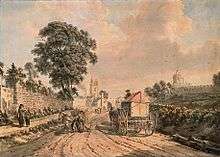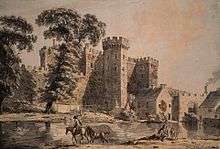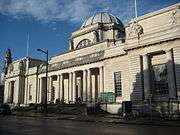Art in Cardiff
Art in Cardiff refers to the culture of visual arts in Cardiff, capital city of Wales. The visual arts in Cardiff have a much more recent history than many British cities, due to it being a very small town until rapid growth took place in the mid nineteenth century. Cardiff School of Art originated in 1865 and the first major public art exhibition took place in 1870.[1] The town became a city in 1905, after which time it gained further importance, for example with the creation of a new National Museum. Into the 21st century it has a thriving art scene.


Background
Cardiff did not become a large town until rapid industrial expansion took place during the second half of the nineteenth century. Artists had visited the town from an earlier date, particularly Paul Sandby (1725/6-1809) painted a number of watercolours of South Wales during his second tour of Wales (1773, published 1775),[2] including of Cardiff's North and West Gates. Wales was unusual because its concentration of visual artists occurred in rural areas (rather than urban centres), drawn there by the impressive scenery. The Cambrian Academy of Art was founded by artists in the Conwy Valley and Betws-y-Coed and art was exhibited at established commercial galleries in Llandudno, on the North Wales coast.[3]
Late 19th century
In 1858 the idea of a town museum for Cardiff had been raised and, in 1861, a museum was created in temporary rooms based on subscriptions,[1] sharing accommodation with the Cardiff Free Library[4] in St Mary Street. In 1870 Cardiff's first large-scale public art exhibition, the Fine Art and Industrial Exhibition, took place.[1] Bequests to the art collection, particularly sculpture (for example from Milo ap Griffith) began to come in.[1]
Central to the town's artistic community at the time were artist T. H. Thomas (1834–1915) and architect Edwin Seward (1853–1924). Thomas exhibited at the 1870 exhibition. Seward studied at Cardiff's College of Art and later designed the town's new Free Library on The Hayes. Both became Presidents of the Cardiff Naturalists' Society and when Thomas inherited a house on The Walk in 1880 this also became a place for intellectual discussion.[1] Seward tried unsuccessfully to establish an art institution in Cardiff to represent the whole of Wales. Exhibitions were held in 1884 and 1885 to raise money for a headquarters for the Cambrian Academy. Instead, Seward and a group of artists created the South Wales Art Society in 1888, with an annual exhibition and lecture programme.[1]
To help fund a new Free Library a second Fine Art and Industrial Exhibition took place in Cardiff's Drill Hall in 1881. T. H. Thomas and Cardiff painters B. S. Marks and Richard Short were on the organising committee. The event attracted further donations to the town's art collection, including the entire collection of William Menelaus after his death in 1882.[1] In 1883 the National Eisteddfod visited Cardiff and Thomas organised the art and craft exhibition and competition, the largest ever event of its kind in Wales at the time. Local painter Edgar Thomas came to the attention and the Marquess of Bute sponsored his continuing art education as a result.[1]
Discussions began in the early 1890s to create a far larger museum and art gallery for Cardiff. The idea that it became a national museum was soon mooted, to rival those in England and Scotland. A site was secured at Park Place for the new building, and the design commissioned from Edwin Seward. In 1896 Cardiff's third Fine Art and Industrial Exhibition took place (with the pavilion designed by Seward), which further brought together a substantial public collection of art, for example from the works of painter Charles Jones (d. 1892).[5] Plans for a new museum were superseded by grander ambitions for new civic buildings on a much larger site, and it was not realised until after Cardiff achieved city status (1905). Seward's designs were used for the application for government funds, but not used for the final building.[5]
Cardiff School of Art
A School of Science & Art was established in Cardiff in 1865,[6] with lessons taking place on the top floor of the Cardiff Free Library and Museum.[4] In 1867 a distinct School of Art was formed, based on the Art Night School.[7] The first South Kensington examinations took place (and prizes awarded) in 1868 (in 1869 the prizes were handed out by Lord Bute).[8] It became the Cardiff Technical School in 1889 (and eventually Cardiff College of Art in 1949).[6]
A purpose built city centre site was opened in May 1970 in Howards Gardens. This was closed in 2014 as the remaining courses were moved to Cardiff Metropolitan University's newly built art college building in Llandaff, bringing all the art and design courses together for the first time in decades.[9]
National Museum of Wales

Art Groups
South Wales Art Society
The South Wales Art Society (SWAS) was formed in 1888 by a group of Cardiff-based members of the art scene, including artists T. H. Thomas and Parker Hagarty, art collector James Pyke Thompson, architects J. A. Sant and Edwin Seward[10] and watercolourist Clarence Waite.[11] SWAS planned to have an annual exhibition, a lecture programme and a sketching club[10] and "offering to those who admire or appreciate, rather than practise, a means of cultivating a taste for Art".[11]
SWAS has continued to hold an annual exhibition in a variety of locations in Penarth and Cardiff. Its 100th exhibition took place at the Turner House Gallery, Penarth[11] and its 127th took place in the Pierhead Building, Cardiff Bay in 2014.[12]
56 Group
The 56 Group was conceived in 1956 by a small group of Cardiff-based artists, Eric Malthouse and David Tinker (who both worked at the Art College) together with Michael Edmonds (an artist/architect). The name 56 Group was conceived at a meeting in a Llandaff pub and the loose organising committee was based in Cardiff. However the group had national ambitions to promote radical and abstract Welsh art[13] and its other founding members were associated with areas outside of Cardiff, such as Newport, Carmarthen, Aberystwyth and the Rhondda valleys.[14]
Arts centres and Galleries
Private galleries
A small number of private art galleries continue to operate in Cardiff. Art in Wales: an illustrated history 1850–1980 describes the standard of exhibitions in Wales private galleries as "uneven", but singles out the Howard Roberts Gallery in Cardiff as one of the "two outstanding private galleries in Wales".[15]
In 1956[16] the Howard Roberts Gallery was created by artist Howard Roberts in four large rooms on St Mary Street.[17] The gallery exhibited established Welsh painters and helped develop the careers of others. It became known as a centre for modernism, signing Ceri Richards and John Piper to its books.[17] The gallery was eventually forced to close in 1970, but left a legacy of art bequests to major Welsh galleries.[17]
Other notable private galleries include the Albany Gallery, Roath, which was opened in 1965 by Mary Yapp and became the agent for Kyffin Williams.[18] The Martin Tinney Gallery opened in 1989 in the city centre, later moving to St Andrews Crescent, and represents major Welsh artists such as Shani Rhys James.[18][19]
G39 is a contemporary art gallery which opened on Mill Lane in the centre of Cardiff in 1998. It moved to larger premises in Roath in 2012.[20]
Oriel
Oriel was an art gallery and bookshop in Charles Street, founded by the Welsh Arts Council in 1975 as its "Window on the Arts in Wales". It mounted influential exhibitions of contemporary art and had a publishing operation. In the late 1980s it moved to the corner of The Friary and Greyfriars Road. It closed in the 1990s when the Welsh Arts Council withdrew funding.[21]
Chapter Arts Centre
Chapter is an arts centre in the Canton district of the city which includes two gallery spaces.
21st century
Artes Mundi
Artes Mundi is an international biennial contemporary art exhibition and prize, held at the National Museum since 2004.
Street art and graffiti
The 'Roxe Jam' hip-hop and graffiti festival took place annually from July 2008 in Sevenoaks Park, Grangetown. The event was set up in memory of a young graffiti writer, Bill Lockwood aka Roxe, who was killed in a road accident. The main street art highlight of the event was the legal painting of a 140 m long wall which runs parallel to the Cardiff to Penarth railway line.[22][23] The festival last took place in 2012.
In October 2013 the Made in Roath collaborated with the Empty Walls project with the intention of painting murals and street art on neglected buildings.[24] The event was brought into Cardiff city centre in 2014. Empty Walls festival sponsored by the Arts Council of Wales took the project to the city centre. The Project was organised by Sam Worthington (Wasp Elder/Colour Doomed) and Helen Bur ( HB) whom formed the arts collective Modern Alchemists, Empty Walls Street Art Festival and the Abacus arts space in Wood Street. It brought together 20 local and international street artists and over 40 murals were painted over the two festivals, together with an indoor exhibition at Abacus.[25]
Made in Roath
Made in Roath is an annual arts festival held in the Roath district of Cardiff.
Public art and sculpture
Sources
- Lord, Peter (2000), The Visual Culture of Wales: Imaging the Nation, Cardiff: University of Wales Press, ISBN 0-7083-1587-9
- Moore, David (2012), A Taste of the Avant-garde: 56 Group Wales, Brecon: Crooked Window, pp. 6–7, ISBN 978-0-9563602-1-2
References
- Peter Lord, The Visual Culture of Wales: Imaging the Nation, page 301–303
- Peter Lord, The Visual Culture of Wales: Imaging the Nation, pages 131–132
- Peter Lord, The Visual Culture of Wales: Imaging the Nation, pages 298–299
- Sixth Annual Report 1867–68. Cardiff Free Library and Museum and Science and Art Schools. 1868. pp. 6–8. Retrieved 2014-11-16.
- Peter Lord, The Visual Culture of Wales: Imaging the Nation, pp. 304–306
- "Our history". Cardiff Metropolitan University. Retrieved 16 November 2014.
- "The Headmaster's Report". Sixth Annual Report 1867–68. Cardiff Free Library and Museum and Science and Art Schools. 1868. pp. 13–14. Retrieved 2014-11-16.
- Matthew Potter, ed. (2013), "Struggling with the Welsh Masters (footnotes)", The Concept of the 'Master'in Art Education in Britain and Ireland 1770 to the Present, Ashgate Publishing, p. 163, ISBN 978-1-4094-3555-6
- Karen Price (6 June 2014). "Discover new art at the degree shows". Wales Online. Retrieved 17 November 2014.
- Peter Lord, The Visual Culture of Wales: Imaging the Nation, page 303–304, includes membership certificate (1888) of H. Clarence Waite
- "South Wales Art Society - Our History". South Wales Art Society. Retrieved 18 November 2014.
- "The long-running South Wales Art Society announces its 127th annual exhibition". Wales Online. 18 August 2014. Retrieved 18 November 2014.
- Moore, David, A Taste of the Avant-garde: 56 Group Wales, pages 6–7
- Moore, David, A Taste of the Avant-garde: 56 Group Wales, pages 8–13
- Rowan, Eric (1985), Art in Wales: An illustrated history 1850–1980, Cardiff: University of Wales Press, p. 158, ISBN 0-7083-0854-6
- "Howard Roberts Gallery". Artists Biographies. Retrieved 2014-12-04.
- Peter Wakelin (17 April 2001). "Howard Roberts: Proprietor of Wales's first successful commercial art gallery". The Guardian. Retrieved 2014-12-04.
- Karen Price (27 February 2009). "Recession bites but investors snap up Welsh art". Wales Online. Retrieved 2014-12-04.
- "Martin Tinney Gallery". Visit Wales. Welsh Government. Retrieved 2014-12-04.
- Nathan Bevan (26 May 2012). "The co-director of Cardiff's g39 contemporary art gallery on why it had to relocate from the city centre". Wales Online. Retrieved 2018-10-14.
- Finch, Peter. "Oriel - How it was". The Peter Finch Archive. Retrieved 4 April 2017.
- "Graffiti art in teenager's memory". BBc News. 26 July 2008. Retrieved 2014-11-19.
- "Roxe Jam shows all the good of hip hop". Metro. 23 July 2008. Retrieved 2014-11-19.
- "Empty backstreet walls of Roath brought to life by Made in Roath festival". Wales Online. 6 November 2013. Retrieved 2014-11-19.
- Sion Morgan (26 September 2014). "Empty Walls Project brightening up Cardiff city centre". Wales Online. Retrieved 2014-11-19.